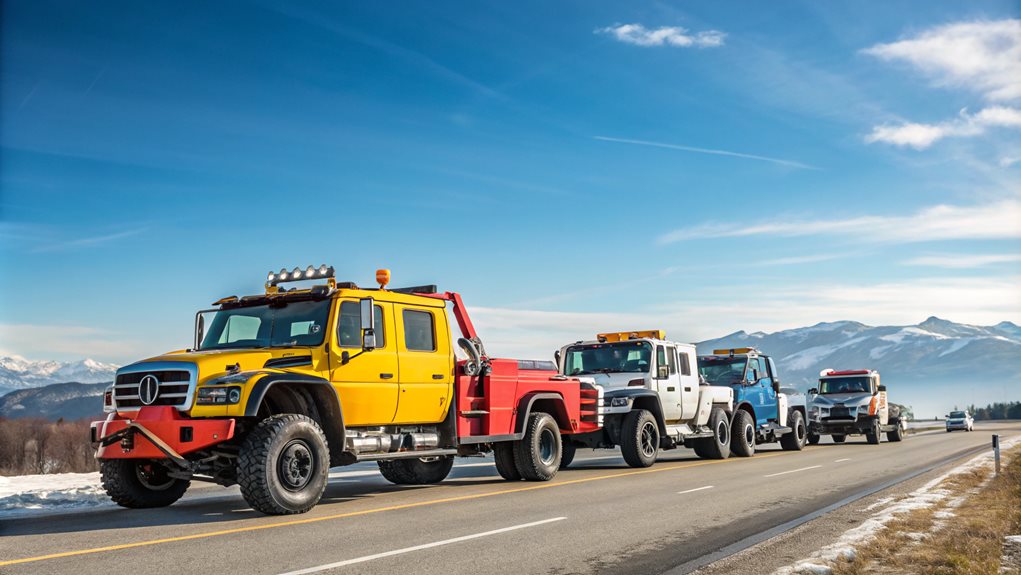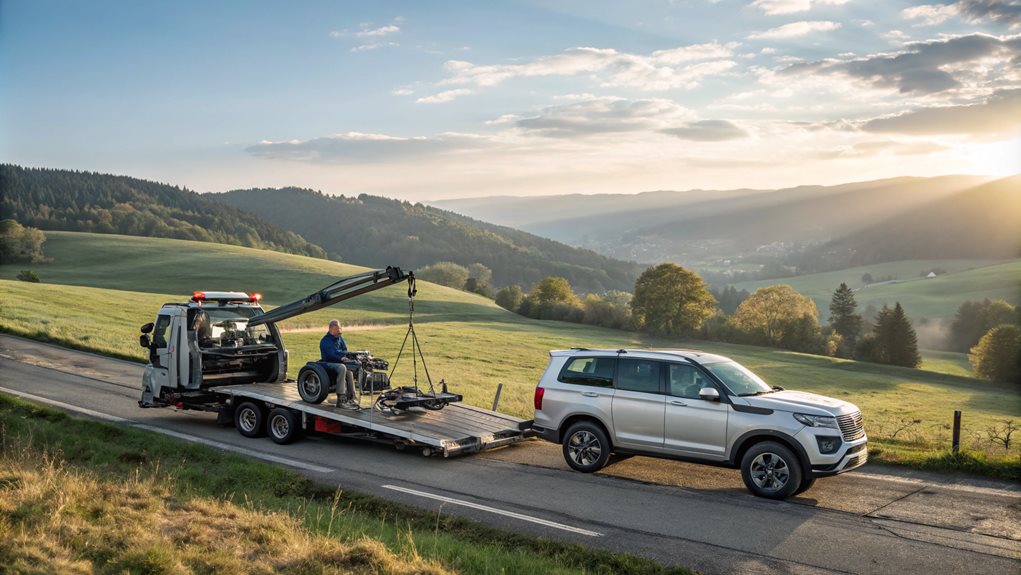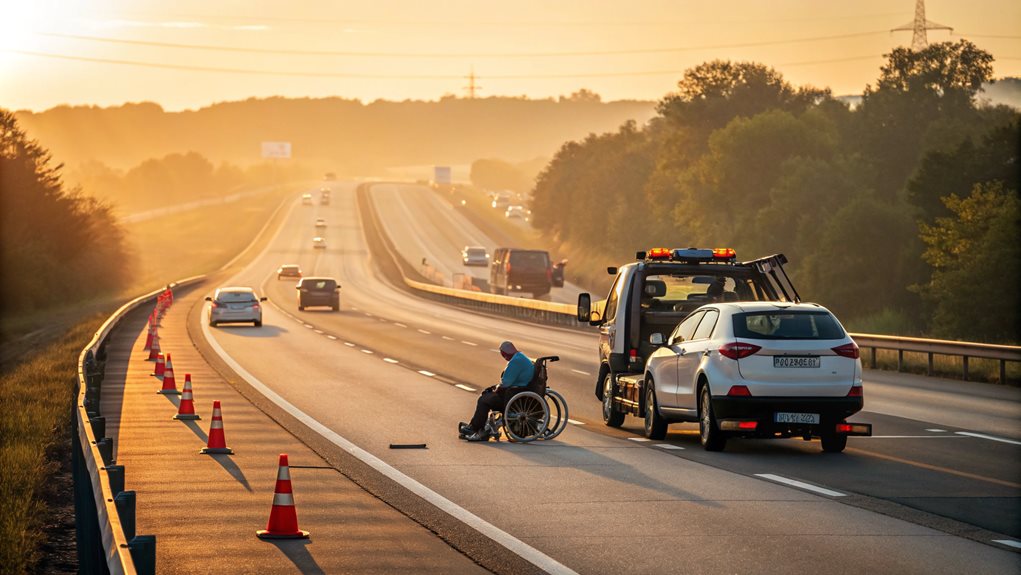Towing services are integral to vehicle recovery, offering vital support through 24/7 emergency roadside assistance and accident scene management. They employ specialized equipment such as winch cables and recovery straps, guaranteeing adherence to rigorous safety protocols to mitigate risks of damage and injuries. Through effective coordination with highway patrol and emergency responders, they clear accident scene debris, handling hazardous materials with precision to prevent secondary accidents and environmental harm. Additionally, these services ensure the secure transport of vehicles, preserving traffic flow across urban and remote areas. Understanding the intricacies of this process reveals the extensive safety measures in place.
Expert Highlights
- Towing services provide essential roadside assistance for disabled vehicles, ensuring safe and efficient transport to repair facilities.
- They utilize secure towing techniques and equipment to minimize damage during vehicle recovery operations.
- Towing services coordinate with emergency personnel to maintain road safety and traffic flow during vehicle recovery.
- Specialized recovery procedures are employed to handle diverse vehicle conditions and environmental obstacles.
- Towing services play a critical role in clearing accident debris, promoting environmental safety and preventing secondary incidents.
Emergency Roadside Assistance

Emergency roadside assistance is an indispensable service that offers critical support in the event of vehicle breakdowns or emergencies. It guarantees peace of mind through a network of reliable providers ready 24/7 via phone, apps, or digital platforms. Towing to the nearest repair facility is a foundational service within these programs, with providers like GEICO, State Farm, and Allstate extending coverage up to 20 miles. Billing can be streamlined directly through insurance, optimizing convenience. For cars, trucks, and standard vehicles, GEICO provides comprehensive services such as towing, battery jump-starts, and lockout assistance. Additionally, services like battery jump-starts and lockout assistance reinforce the comprehensive nature of these plans. The strategic use of GPS and service trackers enhances both response times and service precision, fostering a sense of community-driven support for members, whether they are traversing urban streets or rural roads. Emergency roadside assistance programs in Minnesota offer a wide service area that covers both major cities and rural regions, ensuring timely help is always available. The New York State Thruway exemplifies a high level of safety, ensuring peace of mind for travelers on one of the safest superhighways.
Safe Vehicle Recovery
In achieving safe vehicle recovery, adherence to safety protocols is paramount, necessitating the strategic use of rated recovery points and the proper deployment of equipment such as winch cables or recovery straps to mitigate risks of damage or injuries. Both recovery straps and kinetic recovery ropes offer flexibility, as they stretch considerably during use, thus reducing the impact on recovery points. The process also involves meticulous communication among recovery crew members, ensuring clear exchanges through hand signals or radios to coordinate efforts efficiently. Emphasizing safety is critical, and understanding the breaking strength of recovery gear ensures that it's appropriate for the vehicle being recovered. For individuals experiencing a lockout situation, engaging a roadside assistance team can provide quick and effective solutions without causing further damage to the vehicle. Additionally, clearing any accident scene debris not only facilitates the recovery operation but also serves to uphold road safety, preventing further hazards to both recovery personnel and other road users.
Ensuring Safety Protocols Compliance
Adhering to safety protocols in vehicle recovery is paramount to mitigate risks and guarantee the safety of both the crew and the general public. The exhaustive evaluation of each vehicle's condition ascertains that towing professionals select methods and equipment best suited for safe recovery. Specialized tools, from flatbed trucks to recovery straps with robust strength ratings, are meticulously chosen based on the vehicle's specifications and environmental conditions. Regular inspections and maintenance ensure that all equipment is in optimal condition, promoting continuous improvement practices to identify and rectify potential issues.
- Conduct thorough site assessments to identify potential hazards.
- Engage in continuous communication with highway patrol and emergency responders.
- Equip operators with mandatory safety gear and certify the strategic placement of warning signs.
The meticulous implementation of these protocols nurtures a cohesive, safety-oriented environment, reinforcing a sense of belonging and trust amongst all involved in the recovery process.
Clearing Accident Scene Debris
Managing accident scene debris is a critical aspect of vehicle recovery operations. Towing operators play a pivotal role in clearing a plethora of materials, from innocuous vehicle plastics to hazardous oil spills, using specialized equipment like shovels and liquid-absorbing substances.
Coordination with agencies such as local fire departments and hazmat teams guarantees the safe handling of toxic spills and biohazards, mitigating environmental threats. Part of this process involves potential road closures to efficiently manage cleanup while minimizing traffic congestion.
The precision with which operators execute these tasks, balancing safety and speed, not only prevents secondary accidents but also curtails environmental damage. Their efforts are essential to restoring normal traffic flow and safeguarding public spaces, reinforcing community trust and collaboration.
24/7 Towing Availability

Imagine being stranded on a deserted stretch of highway late at night; the relief provided by 24/7 towing operation is invaluable. This round-the-clock service guarantees that assistance is available at any time, reflecting a deep commitment to prompt vehicle recovery and accident scene management. The prompt arrival of tow trucks ensures secure and safe transport of vehicle, minimizing potential damage during the recovery process. More than merely a convenience, such accessibility is vital in coordinating efforts with emergency services and maintaining traffic flow. The constant readiness offered by towing services provides a tangible sense of security and belonging to all drivers.
The benefits include:
- Emergency Readiness: Accessible day or night, assuring constant support.
- Geographic Coverage: Availability spans urban centers to remote areas.
- Collaborative Efficiency: Enhanced safety through coordination with first responders.
Such services stand as guardians, ever-vigilant on the open roads.
Specialized Equipment Use
In the domain of vehicle recovery, the use of specialized equipment is paramount in ensuring efficient and safe operations, particularly when considering advanced tow truck options and hydraulic tools. Tow truck advancements, such as those equipped with hydraulic systems and GPS technology, allow for precise control and real-time monitoring, essential in both light-duty and heavy-duty recovery scenarios. Additionally, optimized loading techniques, involving equipment like rotator trucks and rigging tools, facilitate the secure and efficient handling of vehicles in challenging circumstances, underscoring the importance of tailored recovery solutions for varying operational needs. The reliable and trustworthy jump start assistance offered in the Minneapolis and St. Paul area exemplifies the critical role of quick and efficient responses in roadside services.
Advanced Tow Truck Options
When it comes to vehicle recovery, advanced tow truck options equipped with specialized equipment play a crucial role in handling diverse and complex towing requirements. Integrated tow trucks combine this advanced technology and robust chassis into one stable unit, ideally suited for larger vehicles such as buses and motorhomes.
Heavy-duty rotator tow trucks, noted for their integrated rotating crane booms, offer unmatched precision in recovering overturned tractor-trailers or large construction equipment. These trucks can handle formidable loads and are indispensable for demanding operations requiring finesse and power.
Specialty tow trucks are tailored for niche markets, such as motorcycles or RVs, featuring unique adaptations to guarantee secure and efficient transport.
- Under-lift Systems: Provides versatile recovery.
- Powerful Winches: Ensures stability.
- Specialized Attachments: Offers adaptability.
Hydraulic Tools Application
Hydraulic tools play a pivotal role in vehicle recovery, complementing the advanced options offered by specialized tow trucks. Utilizing Pascal's Law, hydraulic lifts and winches distribute pressure evenly, allowing operators to lift heavy loads with minimal effort.
This technology is integral to flatbed and wheel-lift tow trucks, facilitating the secure and expeditious loading and unloading of vehicles without damage. In particular, heavy-duty tow trucks leverage hydraulic winches and lift assemblies to manage larger vehicles and complex recovery scenarios.
The precision and capability offered by these tools drastically reduce physical strain on operators, enhancing operational safety. Complemented by specialized recovery tools like air bags, jacks, and dollies, hydraulic systems guarantee efficient, damage-free towing, fostering our collective commitment to safe, reliable vehicle recovery.
Optimized Loading Techniques
Efficient loading techniques are critical in ensuring the safe and balanced transportation of vehicles and goods, made possible through specialized equipment. Implementing optimized loading techniques demands attention to various factors including weight distribution and load security.
Properly allocating weight—60% before and 40% beyond the axle—mitigates swaying, ensuring homologous movement throughout transit. Utilizing advanced systems such as D-rings and E-track anchors guarantees the stability of cargo. Additionally, adopting tools like forklifts and loading ramps facilitates streamlined loading and unloading.
- Weight Distribution: Concentrate heavier loads at the trailer's front center to maintain balance and prevent tipping.
- Load Security: Employ robust tie-down mechanisms to preclude movement.
- Space Optimization: Efficiently arrange cargo using platforms like pallets to optimize space and minimize wind drag.
Expertise and Professionalism

Traversing the intricacies of vehicle recovery requires towing service personnel to possess a high degree of expertise and professionalism, cultivated through specialized training and certification. The Towing and Recovery Association of America's National Driver Certification Program equips operators to adeptly manage a spectrum of scenarios, from towing motorcycles to handling hazardous materials following accidents.
Advanced tools such as flatbed tow trucks and rotators facilitate smooth operations. Equally crucial is the strong emphasis on professionalism, as personnel prioritize passenger safety, deliver clear communication during stressful events, and assist with insurance paperwork, reinforcing a reassuring presence.
This professionalism also extends to roadside assistance, which is crucial for services like tire changes and jump-starts, ensuring customer safety and satisfaction. This established professionalism garners partnerships with agencies and law enforcement, fostering a network of trust and reliability to foster comprehensive support, thus nurturing a sense of belonging within the community.
Traffic Flow and Safety
Guaranteeing the smooth flow of traffic and maintaining safety during vehicle recovery operations is essential in minimizing disruptions and preventing further hazards. Coordinating with law enforcement agencies, towing services efficiently manage traffic, leveraging advanced tools and techniques. By employing specialized equipment, such as rotators and winches, they guarantee quick clearance of accident scenes, thereby mitigating congestion and reducing vehicle strand time. Enhancing response times not only curtails travel delays but also exemplifies the commitment to communal well-being and cohesion. Integral elements of successful traffic and safety management include: – Quick site clearance to keep traffic fluid and reduce public inconvenience. – Collaboration with authorities to maintain control over traffic systems. – Use of specialized equipment that guarantees speedy and safe removal of obstructing vehicles. This strategic approach is crucial for seamless traffic management and community safety. In areas like Dinkytown MN, the availability of roadside assistance services ensures efficient resolution of vehicle issues, contributing to overall traffic fluidity and safety.
Preventing Secondary Accidents

While primary accidents are already challenging for traffic and safety management, preventing secondary accidents is vital to further secure the scene and protect road users. Effective mitigation includes surveying the vicinity for hazardous conditions, particularly near dynamic traffic flows like merging lanes.
Clearly marked warning lights and pylons highlight the recovery site, enhancing visibility for oncoming drivers. The prohibition of flares guarantees the mitigation of fire risks in potential fuel leak scenarios. Clarity and safety rely on the towing vehicle's visibility; hence, it is paramount that it is well-lit. Clearing debris minimizes risks to passing motorists.
Ascertaining all towing connections are properly secured and utilizing the appropriate recovery equipment preserves structural integrity during recovery, fostering enhanced road safety for all users.
Roadside Assistance FAQ
How Much Does a Typical Towing Service Cost?
The typical cost of a towing service ranges from $35 to $275, influenced by factors including distance, time, vehicle size, and conditions. Joining roadside assistance programs or leveraging insurance can offer community benefits and cost-effective solutions.
Is Towing Covered by My Car Insurance Policy?
Towing coverage depends on your insurance policy specifics. Comprehensive coverage or roadside assistance often include towing services. Review your policy's terms for deductibles, limits, and exclusions, and guarantee alignment with the preferred provider network to verify coverage.
Can I Schedule a Tow for a Future Date?
Yes, scheduling a tow for a future date is generally feasible, especially for non-emergency situations. However, availability and advance scheduling policies vary by towing service, so it's important to confirm specifics directly with your chosen provider.
How Long Will the Tow Truck Take to Arrive?
Response time for a tow truck varies. Urban areas average 20-30 minutes, while rural locations may exceed an hour. Factors like traffic, demand, and weather conditions greatly/substantially/considerably influence arrival times, impacting service efficiency and reliability.
Are Pets and Personal Items Allowed in the Tow Truck?
Pets are generally not permitted in tow trucks due to safety concerns, while personal items are subject to specific guidelines. Priority is given to vehicle recovery, with securement processes ensuring no obstruction or hazard from personal belongings.
